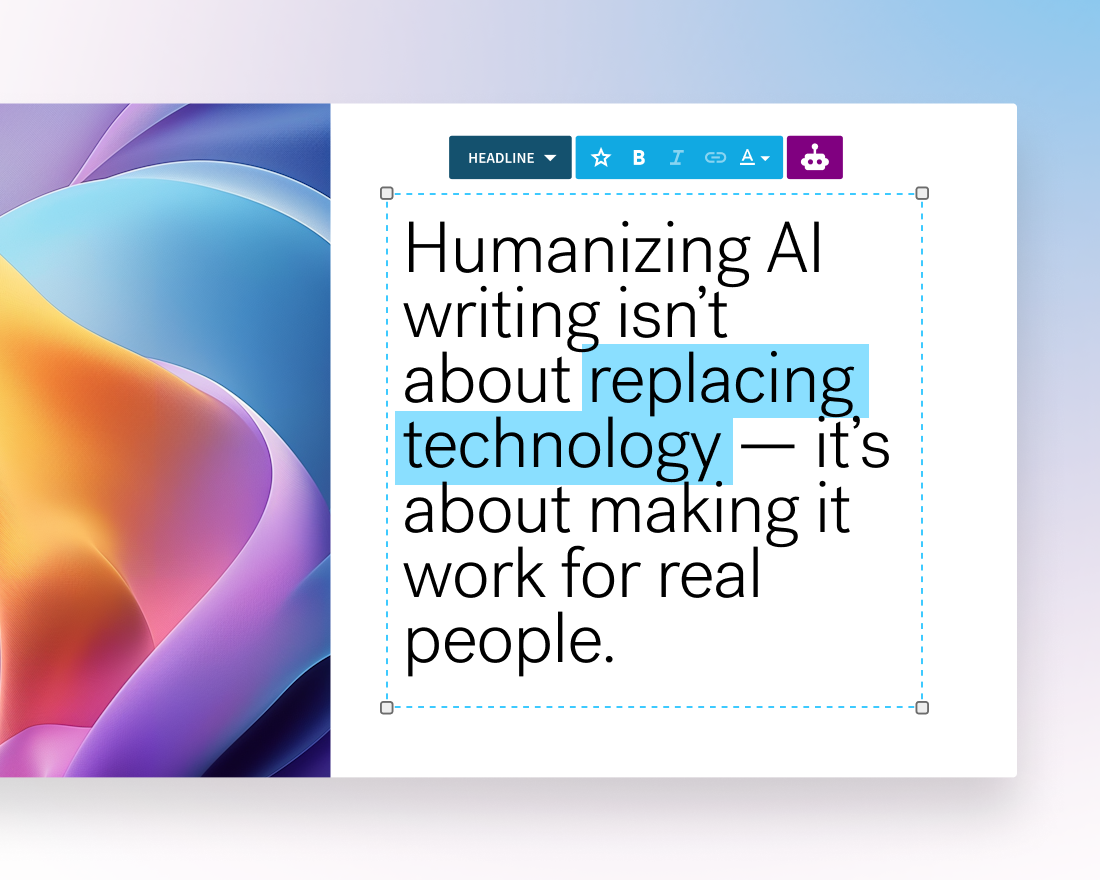
Artificial intelligence has revolutionized the way teams create and share ideas. In the past, building a polished presentation required hours of design tweaks, formatting adjustments, and image sourcing. Today, AI-powered presentation tools—like Beautiful.ai—can do much of that heavy lifting in seconds.
But while AI has transformed how we work, it hasn’t replaced the value of why we work: the human ability to connect, persuade, and inspire. The best presentations don’t just look good—they feel authentic, intentional, and tailored to their audience.
Let’s explore where AI excels in slide creation, where it still falls short, and how the perfect balance between automation and human creativity leads to truly standout presentations.
What AI does well in slide creation
AI thrives when the task is structured, repetitive, or rule-based—and presentation design fits that bill.
1. Automates formatting and layout decisions
One of AI’s biggest strengths is handling the visual mechanics of design. With Smart Slide layouts, your content automatically adapts to the best possible format—text boxes align, images resize, and spacing stays consistent. Tools like Beautiful.ai’s AI-powered slides take care of the design logic for you, ensuring every deck looks professional and on-brand from the first slide to the last.
2. Suggests relevant imagery and visuals
Finding the perfect image or icon can be surprisingly time-consuming. AI solves this by recommending visuals that match your slide content. Whether you’re presenting quarterly metrics or launching a new product, AI can suggest imagery that enhances your message and maintains a cohesive visual tone.
3. Speeds up draft creation from raw notes or outlines
Need to turn a brainstorm or meeting summary into a full presentation? AI can instantly convert bullet points into structured slides with headers, visuals, and suggested talking points. What once took hours now takes minutes—freeing teams to focus on refining the story rather than formatting slides.
Where AI falls short
Despite its power, AI still lacks something essential: human context.
1. Context-specific nuance
AI can misinterpret industry-specific language, cultural nuance, or company tone. For example, what works for a tech startup pitch might feel off in a financial board meeting. Humans understand these subtle differences and can adjust language, pacing, and emphasis accordingly.
2. Emotional storytelling and tone of voice
AI can structure a story—but it doesn’t feel one. It can generate text that reads well but doesn’t always resonate emotionally. The human ability to tell stories, convey excitement, or build suspense is what turns a set of slides into a persuasive narrative.
3. Understanding brand guidelines and design cues
AI can maintain visual consistency, but it can’t always interpret the subtleties of brand identity—the balance between boldness and restraint, or how a brand represents itself through color, typography, and imagery. Those cues require a human’s eye.
The risk of overreliance
Relying too heavily on AI can make presentations look polished but sound hollow. While automation speeds up creation, it also introduces subtle risks that only human judgment can catch. AI-generated content, for instance, can occasionally include inaccuracies or outdated information—without human review, even small errors can undermine credibility. It also tends to default to safe, generic language that lacks brand personality or originality, causing your message to blend into the noise rather than stand out. Most importantly, AI can’t truly understand an audience’s motivations or emotional cues. It doesn’t recognize when a story needs more empathy or when a data point needs to be reframed for impact. That’s where humans make the difference—by fact-checking, refining tone, and bringing the kind of real-time connection that turns a good presentation into a memorable one.
The ideal workflow: AI as a collaborative partner
The sweet spot lies in combining AI’s efficiency with human empathy and judgment. Start by using AI to generate a strong first draft and visual framework—let it organize slides, recommend layouts, and suggest visuals to save valuable time and establish a solid design foundation. Then step in to review the work with a human lens, refining the narrative for accuracy, tone, and strategic emphasis. This is where emotional intelligence comes into play, ensuring the story feels authentic and intentional. Finally, customize the presentation for your specific audience by adding real examples, client insights, and company wins that make your message resonate on a personal level. When AI handles the structure and humans craft the story, the result is a presentation that’s both efficient and deeply engaging.
Practical tips for adding the human touch
- Fact-check all AI-generated content. Even small inaccuracies can weaken credibility.
- Infuse brand personality and voice. Use words, phrasing, and visuals that reflect your company’s identity.
- Add personal anecdotes or case studies. Real stories resonate more than generic claims.
- Refine with audience insight. Ask: What do they care about most? What motivates them?
- Use AI as your assistant, not your author. Let it handle the logistics so you can focus on the story.
Unlocking more creativity with Beautiful.ai’s AI-powered presentation software
AI is transforming how presentations are made, but it’s the human touch that makes them memorable. The most effective workflow isn’t AI versus human—it’s AI and human. With tools like Beautiful.ai, teams can start smarter, work faster, and design beautifully, then add the insight, empathy, and personality that only people can provide.
The power of Beautiful.ai lies in an intentional blend of AI features and Smart Slide layouts. You can get your first draft in just a few clicks by prompting the AI with text and documents, and quickly add, edit, or replace content with Smart Slides. Think of Beautiful.ai’s AI as your brainstorming partner to get you a working draft of your deck rather than staring at a blank slide, and the Smart Slides as your designer. The technology baked into Smart Slides automatically adapts as you add or edit content on the slide, so your deck stays balanced and consistent as you go. With a solid starting point, and quick edits that don’t leave you wrestling with formatting, you can perfect your deck in record time.
When AI handles the structure and humans shape the story, productivity meets creativity—and that’s when presentations truly come alive.
.png)
.png)





